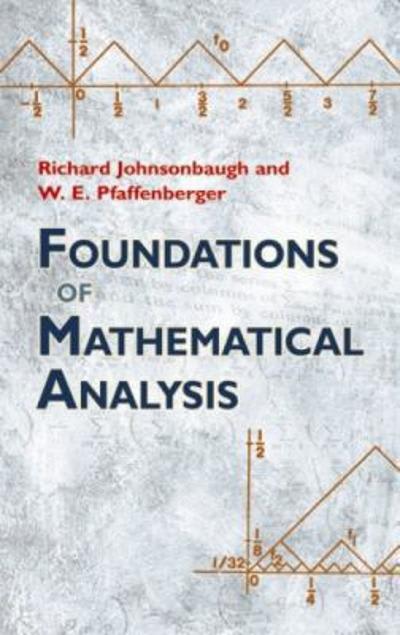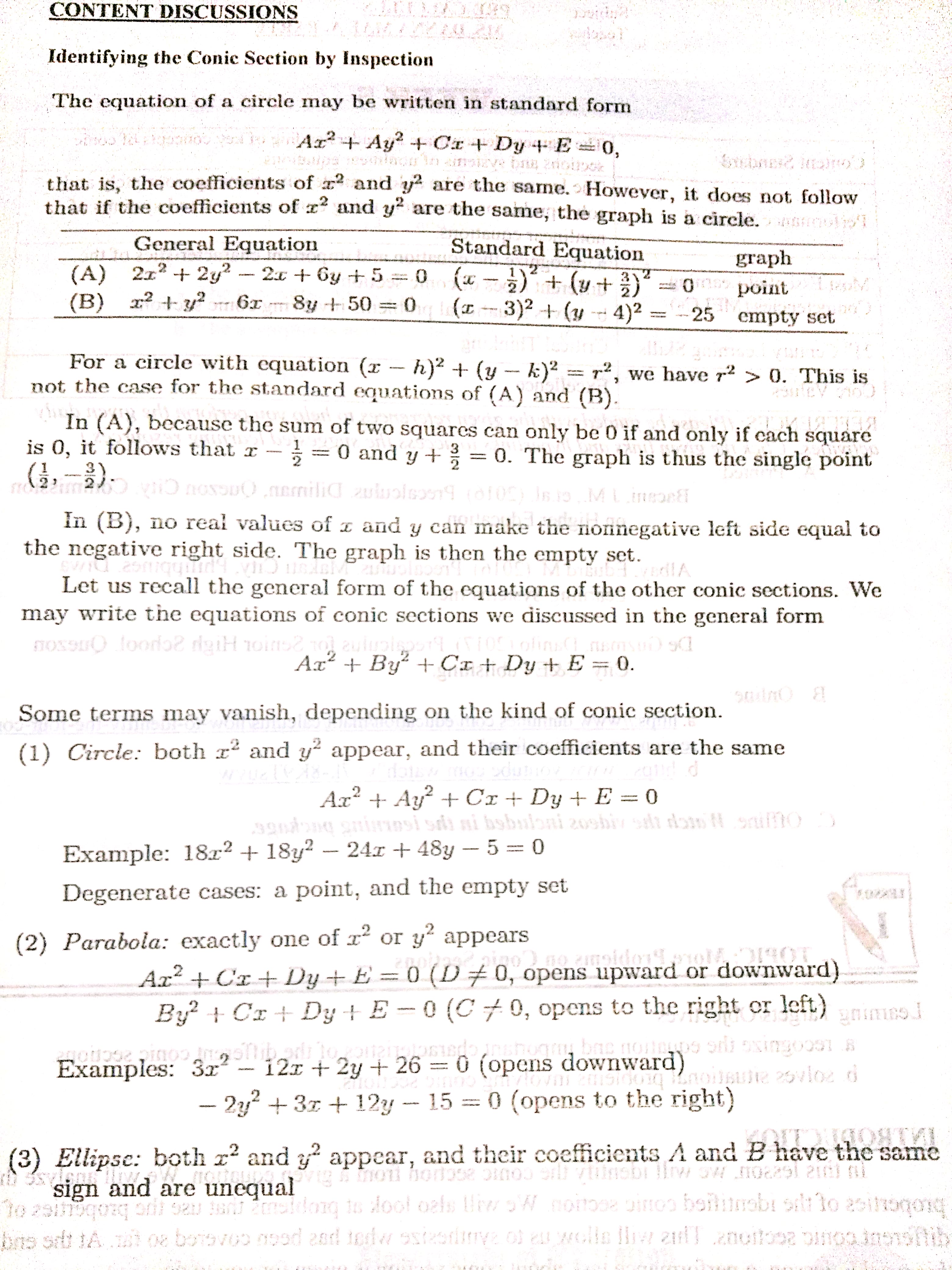
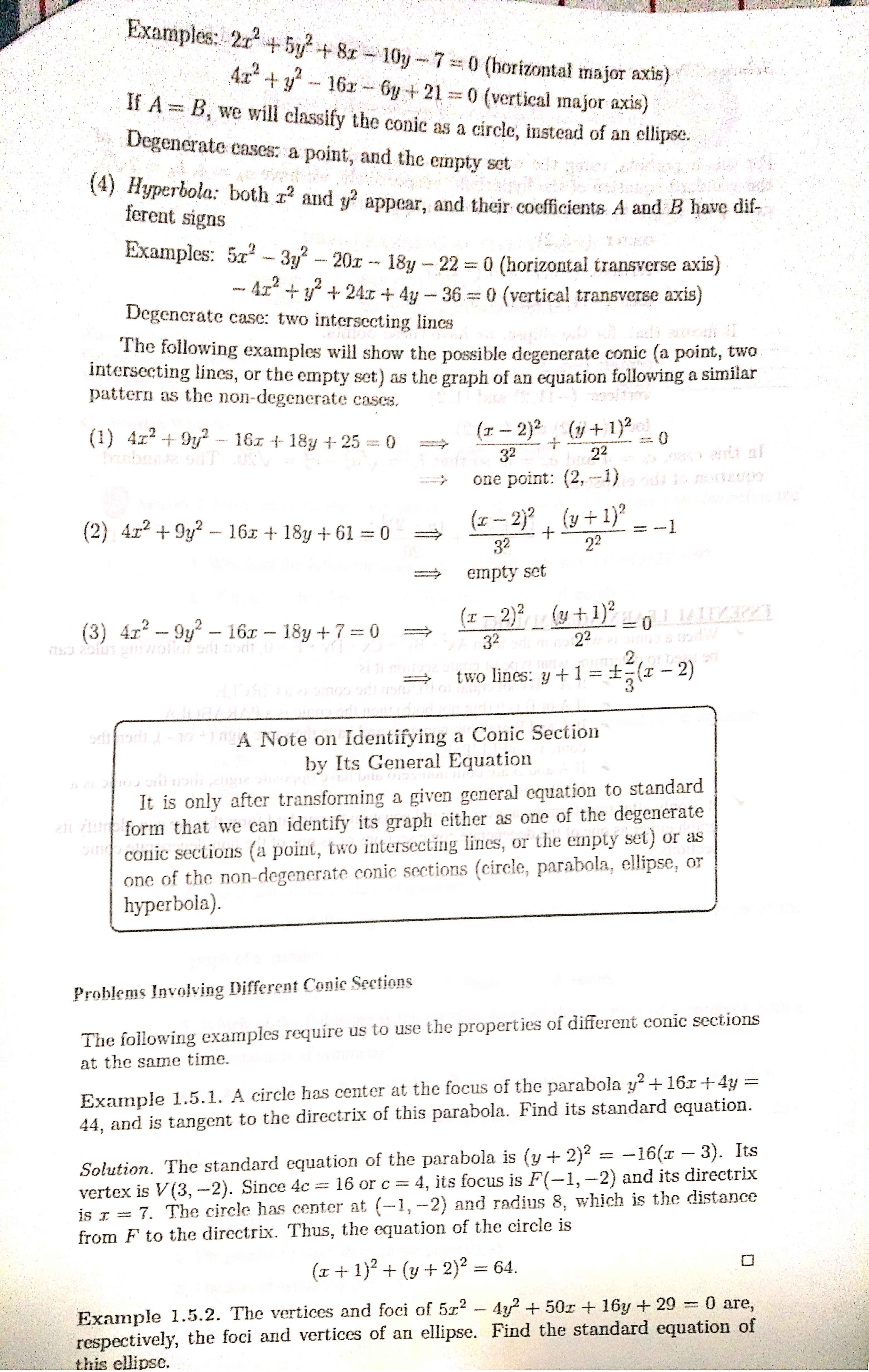
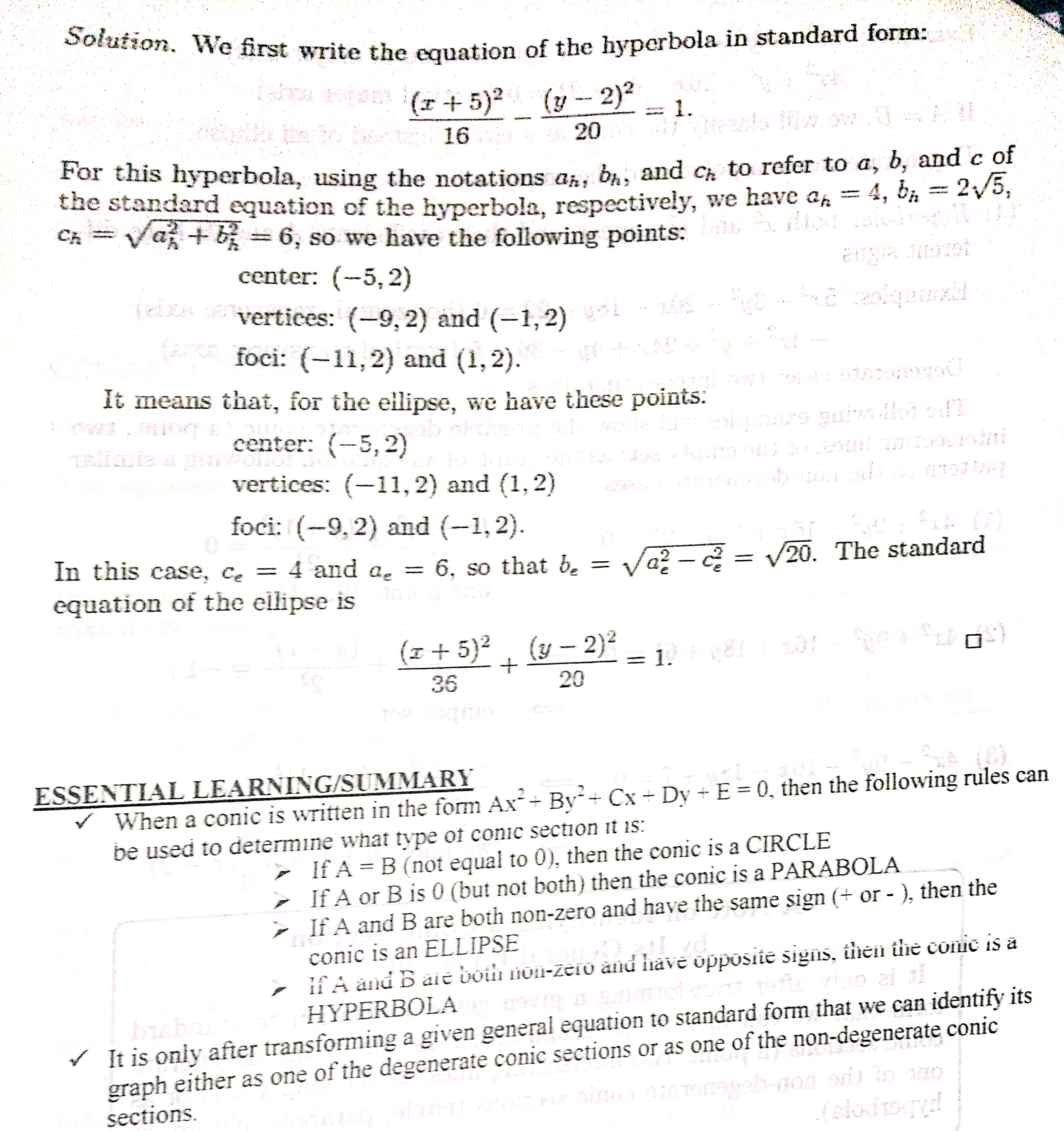
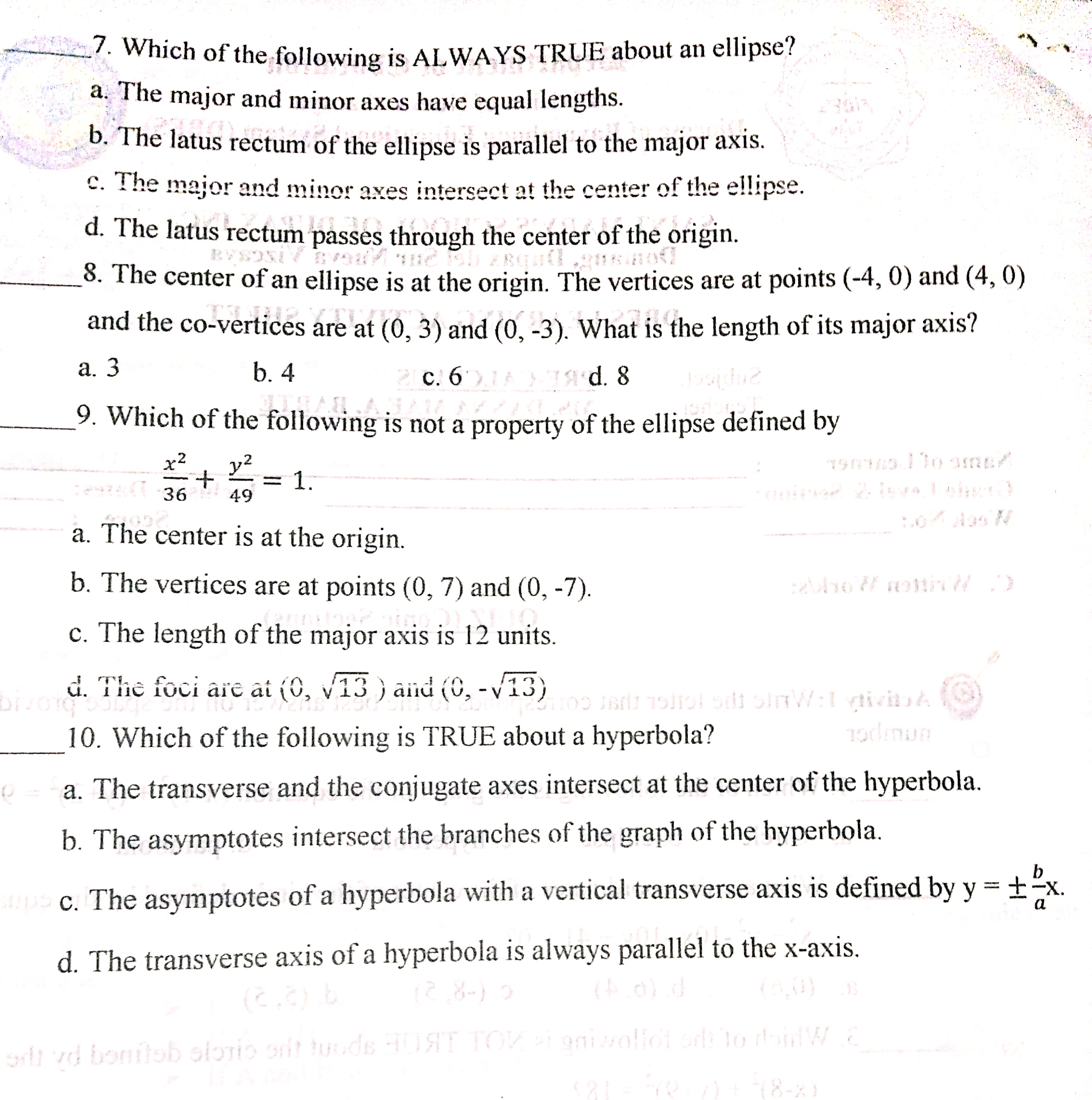
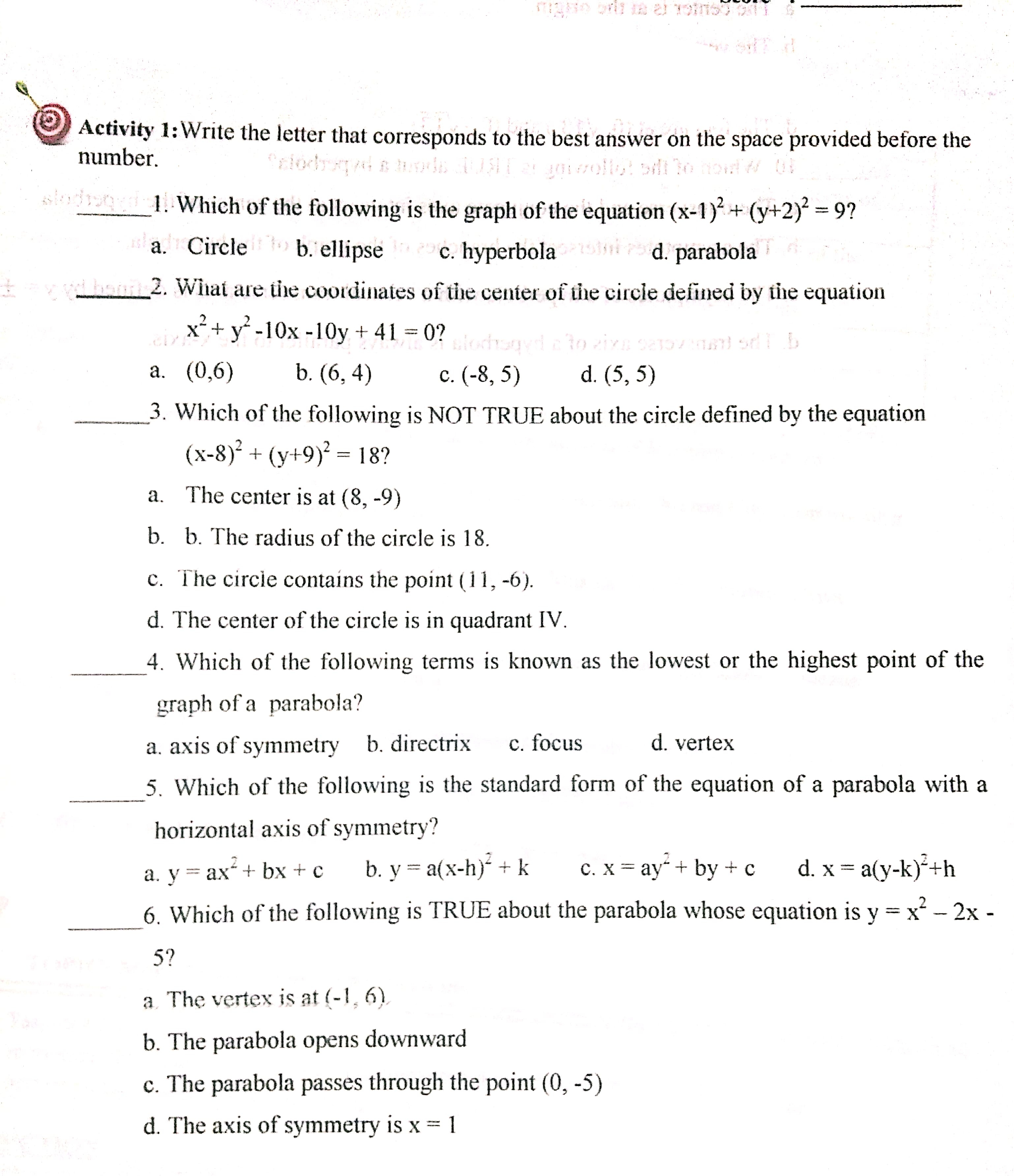
CONTENT DISCUSSIONS Identifying the Conic Section by Inspection The equation of a circle may be written in standard form to megood Ar + Ay' + Ca + Dy 4 E= 0, that is, the coefficients of a2 and yz are the same. However, it does not follow that if the coefficients of 2" and y? are the same, the graph is a circle. spamgulp' General Equation Standard Equation graph (A) 212+ 232-21+6y+5=0 (x-}) + (#+ }) =0 point (B) x? + y' 61 8y +50 =0 (x -3)2 + (1 - 4)2 = 25 empty set For a circle with equation (x - h)? + (y - k)2 = r2, we have > > 0. This is not the case for the standard equations of (A) and (B). In (A), because the sum of two squares can only be 0 if and only if cach square is 0, it follows that r - = = 0 and y + . = 0. The graph is thus the single point In (B), no real values of a and y can make the nonnegative left side equal to the negative right side. The graph is then the empty set. Let us recall the general form of the equations of the other conic sections. We may write the equations of conic sections we discussed in the general form 1039DO toordo? rigiH 1010152 Ax' + By' + Cr + Dy + E =0. Some terms may vanish, depending on the kind of conic section. (1) Circle: both x and y' appear, and their coefficients are the same Ax + Ay + Cr + Dy + E = 0 sendone suitinst sthi ai bebuloni 20shiv sthi doin il srimo Example: 1812 + 18y? - 241 + 48y - 5 = 0 Degenerate cases: a point, and the empty set (2) Parabola: exactly one of 12 or y appears Ar" + Cx + Dy + E = 0 (D / 0, opens upward or downward) By? + Cx+ Dy + E -0 (C 0, opens to the right or left) PRIMES ps affi skingoout s Examples: 3x - 121 + 2y + 26 =0 (opens downward) - 2y"+3x+ 12y -15 =0 (opens to the right) (3) Ellipse: both x2 and y appear, and their coefficients A and B have the same sign and are unequal naldong is doo! ols Wee W nonose smoo bathingbe sili to asthogongExamples: 212 + 5y + 8x - 10y -7 =0 (horizontal major axis) Ar + y' -- 16r - 6y + 21 = 0 ( vertical major axis) If A = B, we will classify the conic as a circle, instead of an ellipse. Degenerate cases: a point, and the empty set gobs ofitaly ferent signs (4) Hyperbola: both r? and y? appear, and their coefficients A and B have dif- Examples: 5x' - 39 -- 201 - 18y -22 =0 (horizontal transverse axis) -Ar"+ y' + 24x + 4y - 36 = 0 (vertical transverse axis) Degenerate case: two intersecting lines The following examples will show the possible degenerate conic (a point, two intersecting lines, or the empty set) as the graph of an equation following a similar pattern as the non-degenerate cases. (1) 412 + 912 - 161 + 18y + 25 = 0 (1 - 2)2 (7 + 1)2 0 = 0 32 22 one point: (2, 1)sai monsugg (2) 4x2 + 9y2 - 161 + 18y + 61 = 0 (x - 2)? , (y + 1)2 = -1 32 22 empty set (3) 412- 9y' - 161 - 18y + 7 =0 # (I - 2)? 32 22 two lines: y + 1 = +=(x -2) 19did - 10 )A Note on Identifying a Conic Section by Its General Equation It is only after transforming a given general equation to standard form that we can identify its graph either as one of the degenerate conic sections (a point, two intersecting lines, or the empty set) or as one of the non-degenerate conic sections (circle, parabola, ellipse, or hyperbola). Problems Involving Different Conic Sections The following examples require us to use the properties of different conic sections at the same time. Example 1.5.1. A circle has center at the focus of the parabola y' + 16 + 4y = 44, and is tangent to the directrix of this parabola. Find its standard equation. Solution. The standard equation of the parabola is (y + 2)? = -16(x - 3). Its vertex is V (3, -2). Since 4c = 16 or c = 4, its focus is F(-1, -2) and its directrix is r = 7. The circle has center at (-1, -2) and radius 8, which is the distance from F to the directrix. Thus, the equation of the circle is (x + 1)2 + (y + 2)2 = 64. O Example 1.5.2. The vertices and foci of 5x2 - Ay + 50x + 16y + 29 = 0 are, respectively, the foci and vertices of an ellipse. Find the standard equation of this ellipse.Solution. We first write the equation of the hyperbola in standard form: (y - 2)2 16 20 . = 1. For this hyperbola, using the notations an, ba, and ch to refer to a, b, and c of the standard equation of the hyperbola, respectively, we have an = 4, b; = 2v5, ch = va; +b, = 6, so we have the following points: center: (-5, 2) tells vertices: (-9, 2) and (-1, 2) foci: (-11, 2) and (1, 2). It means that, for the ellipse, we have these points: center: (-5, 2) vertices: (-11, 2) and (1, 2) foci: (-9, 2) and (-1, 2). In this case, ce = 4 and a. = 6, so that be = va? - c. = v20. The standard equation of the ellipse is (1 + 5)2 (y - 2)2 36 20 ESSENTIAL LEARNING/SUMMARY When a conic is written in the form Ax~+ By + Cx + Dy + E =0, then the following rules can be used to determine what type of conic section it is: If A = B (not equal to 0), then the conic is a CIRCLE If A or B is 0 (but not both) then the conic is a PARABOLA If A and B are both non-zero and have the same sign (+ or - ), then the conic is an ELLIPSE If A and B are both non-zero and have opposite signs, then the conic is a HYPERBOLA It is only after transforming a given general equation to standard form that we can identify its graph either as one of the degenerate conic sections or as one of the non-degenerate conic sections. Tongpob-won on to sao7. Which of the following is ALWAYS TRUE about an ellipse? a. The major and minor axes have equal lengths. b. The latus rectum of the ellipse is parallel to the major axis. c. The major and minor axes intersect at the center of the ellipse. d. The latus rectum passes through the center of the origin. 8. The center of an ellipse is at the origin. The vertices are at points (-4, 0) and (4, 0) and the co-vertices are at (0, 3) and (0, -3). What is the length of its major axis? a. 3 b. 4 c. 631/ } 79 d. 8 9. Which of the following is not a property of the ellipse defined by 36 49 - = 1. a. The center is at the origin. b. The vertices are at points (0, 7) and (0, -7). c. The length of the major axis is 12 units. d. The foci are at (0, v13 ) and (0, - v13) 10. Which of the following is TRUE about a hyperbola? Todmun a. The transverse and the conjugate axes intersect at the center of the hyperbola. b. The asymptotes intersect the branches of the graph of the hyperbola. c. The asymptotes of a hyperbola with a vertical transverse axis is defined by y = =x. d. The transverse axis of a hyperbola is always parallel to the x-axis. (2 8-) 0 will yd bonitab sloris and wods HUSIT TOVie eniwolfot ard to ramW aActivity 1: Write the letter that corresponds to the best answer on the space provided before the number. 1. Which of the following is the graph of the equation (x-1)2 + (y+2) = 9? a. Circle b. ellipse c. hyperbola d. parabola 2. What are the coordinates of the center of the circle defined by the equation x+y"-10x -10y +41=0? endednava sadand sell b a. (0,6) b. (6, 4) C. (-8, 5) d. (5, 5) 3. Which of the following is NOT TRUE about the circle defined by the equation (x-8)' + (y+9) = 18? a. The center is at (8, -9) b. b. The radius of the circle is 18. c. The circle contains the point ( 1 1, -6). d. The center of the circle is in quadrant IV. 4. Which of the following terms is known as the lowest or the highest point of the graph of a parabola? a. axis of symmetry b. directrix c. focus d. vertex 5. Which of the following is the standard form of the equation of a parabola with a horizontal axis of symmetry? a. y = ax*+ bx +c b. y=a(x-h)" + k c. x= ay + by + c d. x=a(y-k)-th 6. Which of the following is TRUE about the parabola whose equation is y = x - 2x - 5? a The vertex is at (-1, 6) b. The parabola opens downward c. The parabola passes through the point (0, -5) d. The axis of symmetry is x = 1
















